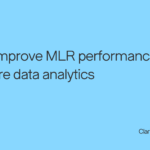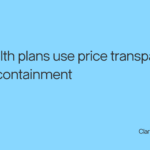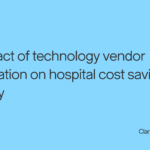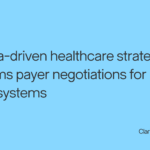Market Access Interview While pharma companies are continuously innovating internal processes and implementing novel technologies to gain efficiencies across R&D and commercial, one function has lagged the others: market access reporting. It’s a process that I believe is ripe for innovation, but I wanted to hear from an expert with hands-on market access pharma reporting experience about its ripe for innovation. I sat down with Colin Taggart, Director of Life Sciences Implementation at Clarify Health, who previously spent five years at ZS Associates as a market access consultant to top 20 pharmaceutical companies. We spoke about the current market access life sciences reporting process, where challenges still exist, and the latest innovations. HELLMAN: Thanks for joining me today, Colin. I want to start off by understanding how pharma does market access reporting today. TAGGART: There are two main types of market access analytical activities that teams run—contract negotiation and pull-through optimization. But from an analytics and reporting standpoint, many of the analyses in these workstreams boil down to the same process. Every year in the summer and fall, it is contracting season, when pharma companies work with insurers to negotiate rebates for various access levels (i.e., prior authorizations, step edits, and tiering). Pharma companies will offer different rebates for different access levels, negotiating with insurers to find a price point and expected market share that maximizes profitability. All the background analysis prior to the negotiation is done by the market access and commercial analytics teams, often in partnership with consultants. Ultimately, the analysis and reporting work is done to assess what a product’s long-term market share would be with “favorable” access relative to “unfavorable” access. For example, you could have a product that is mostly used as a second-line therapy, but an insurer agrees to give it first-line access for a 50% rebate. In this case, the market access team would want to calculate how much their market share would improve with first-line access based upon an assessment of their own product performance and that of competitors and analog therapies. While simple in concept, this process can be very complex. Every payer has different patient populations, physician populations, ways of behaving, geographic access landscapes, and contract cycles. Additionally, market access teams must also work closely with brand and medical teams to ensure that the important patient cohorts are addressed with whatever access is attained. So far, we’ve only discussed the first use case of contract negotiation. Pharma teams also work tirelessly to analyze how to better pull through performance of the access that they purchased. This requires constant reporting of healthcare professional-and site-level metrics to sales, so they have updated target lists to identify where performance is lacking relative to market access. A software that automatically analyzes claims-based performance to market share over time would alleviate the effort that goes into updating and sharing reports for pull-through activities. HELLMAN: This sounds like a complex reporting process. What challenges do pharma companies face when doing market access reporting? TAGGART: There are a few challenges. Some are very technical, and others are process related. On the technical side, a key challenge is purchasing and merging formulary data from different sources to get insights. There can be tension with all the different data providers. The data vendors can be very particular in how their data is treated or merged with other sources. From an efficiency perspective, the constant merging of sources can be a huge burden. Data processing and ingestion is a long and manual process. Lots of analyses are left on the table due to these difficulties, and most pharma companies rely heavily on consulting firms to do the heavy lifting. Another challenge is efficiency. Consulting firms play a significant role in the reporting process, and it’s a manual process that’s labor intensive and open to human error. One of the ways it’s inefficient is that analyses are not repeatable—all the work is done custom. This makes data refreshes and report updates very cumbersome (and expensive). For example, for a consultant to complete the data analysis for both contract market access negotiations and pull through there would be a project fee, but if the pharma company needs a refresh (which always happens) it’s an added cost. It’s a constant budget drain, and that isn’t even including the cost to purchase the data from the data vendors which can be upward of hundreds of thousands of dollars. HELLMAN: Are teams aware of this and all the market access challenges and inefficiency that is created? TAGGART: The commercial analytics teams will be. But I haven’t thought about that, and you’re right. That’s a huge problem because the people that are aware of how difficult it is probably are not going to be the decision-makers. HELLMAN: What are some ways pharma can solve these inefficiencies? TAGGART: Market access reporting today is extremely manual—it’s not efficient nor scalable. The most sophisticated it’s gotten is feeding basic table-based exports into the customer relationship management (CRM) system. However, software has the potential to bring a whole new level of efficiency to market access teams for their monthly analyses and reporting. That’s why we built Clarify Access, a software that generates market access reports on demand. In software, updates to data, analyses, and reports are much easier. Software can be refreshed instantly versus consultants have to go back to the drawing board every time new claims or data comes in. Another efficiency is you can be exploratory with software, which reduces the need for manually combing through patient-and HCP- level data. HELLMAN: Overall, what benefit would pharma companies obtain from these types of efficiencies? TAGGART: I think we touched upon a few, but the biggest one would be cost, both monetary and time. When you can automate a lot of the manual processes involved it translates to significant cost savings across multiple teams. This is a yearly process and over time that adds up. When manual effort is no longer a barrier, market access teams can pursue even more complex use cases. Software makes reporting efficient, while the consulting model is inherently time-based, and drives up cost. Over the long term, pharma companies could save hundreds of thousands, if not millions, of dollars by using on-demand software for market access reporting.
Interviewer: Rachael Hellman
Interviewee: Colin Taggart
- Author Details





